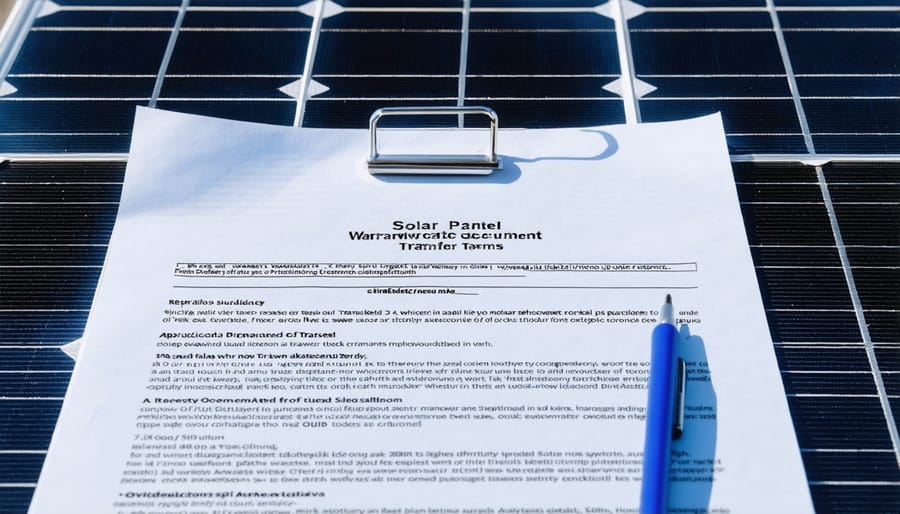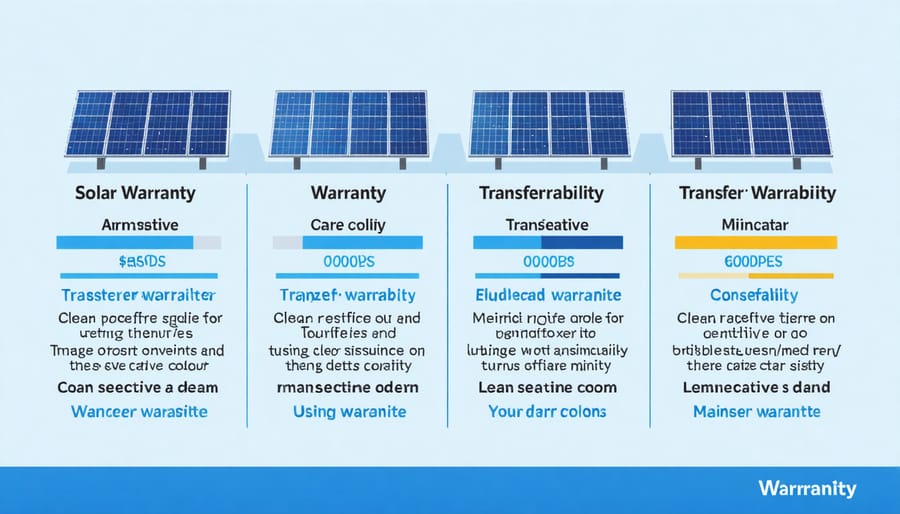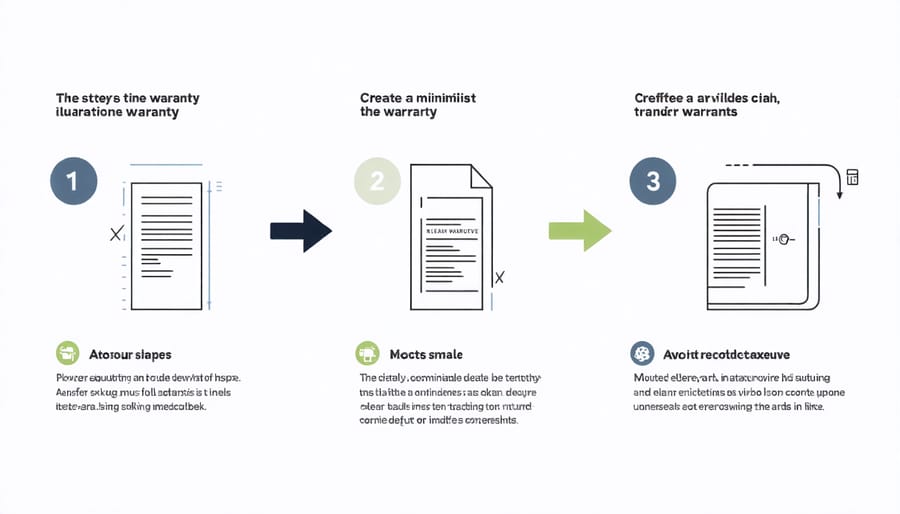When selling or buying a home with solar panels, warranty transferability can significantly impact your ability to protect your solar investment. Most major solar manufacturers offer transferable warranties that seamlessly transition to new homeowners, typically covering performance and equipment for 25 years. However, the transfer process isn’t automatic – specific documentation and registration requirements must be met within strict deadlines to maintain coverage. Understanding these warranty transfer options before a home sale not only preserves valuable protection but can also increase your property’s market value. Whether you’re a seller preparing for a move or a buyer exploring homes with existing solar installations, knowing exactly how these warranties transfer ensures you maintain crucial coverage and maximize the long-term benefits of your solar energy system.
Understanding Solar Panel Warranty Transfers

Types of Solar Warranties That Can Transfer
When it comes to solar installations, there are typically three main types of warranties that can transfer to new homeowners, each protecting different aspects of your solar investment. Understanding these warranties is crucial, as they can significantly impact the expected lifespan of solar panels and their performance over time.
The product warranty, often called the equipment warranty, covers physical defects in your solar panels and typically transfers to new owners with minimal paperwork. This warranty usually lasts 10-12 years and protects against manufacturing defects, material issues, and premature wear and tear.
Performance warranties are the longest-lasting type, usually extending 25-30 years. These guarantees ensure your panels maintain a specified power output level over time. Most manufacturers make these warranties transferable, though they may require notification of ownership change.
Workmanship warranties, provided by your installation company, cover the quality of installation work and typically last 5-10 years. While these warranties commonly transfer to new owners, their transferability can vary by installer. Some companies may require a small fee or inspection before transferring the warranty.
It’s worth noting that while most warranties are transferable, the process usually requires proper documentation and may involve notifying both the manufacturer and installer of the ownership change. This helps maintain continuous coverage and ensures new homeowners can access warranty benefits if needed.

Common Transfer Restrictions to Know
While many solar panel warranties are transferable, it’s important to understand common restrictions that might affect the transfer process. Most manufacturers require written notification of property ownership change within a specific timeframe, typically 30-90 days after the sale. Failing to submit this paperwork could void the warranty completely.
Some warranties may only allow a one-time transfer, meaning subsequent homeowners won’t receive coverage. Others might reduce the coverage period or benefits after transfer. For example, a 25-year warranty might decrease to 20 years for the new owner.
Installation warranties often have different transfer requirements than equipment warranties. If your solar system was installed by a local company that has since gone out of business, the installation warranty might become void, even if it was originally transferable.
Lease agreements can complicate transfers further. If your solar panels are leased, the new homeowner must qualify for and agree to take over the lease terms. This usually involves a credit check and formal approval process.
Modifications to the system can also affect warranty transfers. If previous owners made unauthorized changes or used non-approved components, manufacturers might deny warranty coverage to new owners. Regular maintenance records and professional inspections can help ensure a smooth warranty transfer process.

How to Transfer Your Solar Panel Warranty
Required Documentation
When transferring a solar panel warranty to a new homeowner, you’ll need to gather several essential documents. The main document is the original warranty certificate, which outlines the coverage terms and conditions. You’ll also need proof of the initial installation, including the installation date and the installing company’s details.
Additional required documentation typically includes:
– A completed warranty transfer form (provided by the manufacturer)
– Proof of home ownership transfer (closing documents or deed)
– Current contact information for both the seller and buyer
– System maintenance records and inspection reports
– Original purchase agreement or contract
– Solar panel system specifications
– Recent performance monitoring data
Most manufacturers require these documents to be submitted within 30-60 days of the property transfer. It’s recommended to keep digital copies of all documentation and submit them together as a complete package. Some manufacturers may charge a small processing fee for the warranty transfer, so be prepared to include payment information as well.
Remember to notify your solar monitoring service provider about the ownership change to ensure uninterrupted system performance tracking.
Transfer Timeline and Costs
The timeline for transferring a solar panel warranty typically ranges from 2-4 weeks, though this can vary depending on the manufacturer and warranty provider. Most companies process transfers within 30 days of receiving all required documentation. The good news is that many manufacturers don’t charge a fee for transferring warranties to new homeowners.
However, some companies may charge a nominal processing fee, usually between $50 to $150, to cover administrative costs. This fee often includes updating records, issuing new warranty documentation, and registering the new owner in their system. It’s important to factor these potential costs into your home sale or purchase negotiations.
To ensure a smooth transfer process, gather all necessary documentation early. This typically includes the original warranty certificate, proof of installation, maintenance records, and property transfer documents. Some manufacturers also require a professional inspection before approving the transfer, which could add $100-$200 to the overall cost.
Keep in mind that expedited processing may be available for an additional fee, typically ranging from $75-$150, if you need the transfer completed more quickly.
Tips for Smooth Warranty Transfers
To ensure a smooth warranty transfer for your solar panels, start by gathering all relevant documentation, including the original warranty certificate, purchase agreement, and installation records. Keep detailed records of how you maintain your solar system to demonstrate proper care and compliance with warranty requirements.
Contact your solar panel manufacturer or installer well in advance of any property sale to understand their specific transfer procedures. Many companies require written notification and may have forms that need to be completed by both the current and new homeowners. Some manufacturers also charge a nominal transfer fee, so be sure to factor this into your plans.
Schedule a professional inspection of your solar system before transfer to ensure everything is in working order. This can help prevent any warranty disputes during the transfer process and gives the new owner peace of mind.
When selling your home, include solar warranty information in your disclosure documents and make copies of all relevant paperwork for the new owner. Consider creating a digital folder with all warranty documents, maintenance records, and contact information for the manufacturer and installer.
Work with a real estate agent who understands solar installations and can properly communicate the value of transferable warranties to potential buyers. This helps ensure the warranty transfer process is handled correctly during the sale and closing process.
Solar panel warranty transferability is a valuable feature that can enhance your home’s resale value and provide peace of mind for future owners. As we’ve explored, most manufacturer warranties are indeed transferable, though the process and requirements vary by company. Remember to keep detailed records of your solar installation, maintain proper documentation, and follow the manufacturer’s guidelines for warranty transfers. When selling your home, work closely with your solar provider and real estate agent to ensure a smooth transition of warranty coverage. By understanding and properly managing your solar panel warranty, you’re not only protecting your investment but also contributing to the long-term sustainability and value of your property.









